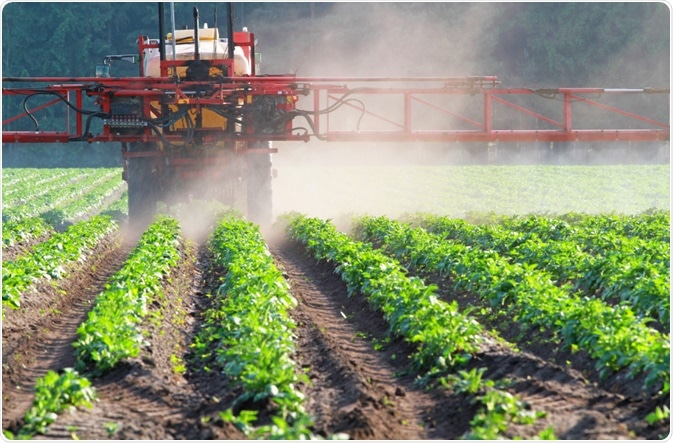Pesticides are widely used around the world to maximize agricultural yield. However, their full effects on human health and the environment in which they are used are still under investigation. As consumers become progressively more aware of what is in their food, pesticide analysis is becoming increasingly important.
 Canetti | Shutterstock
Canetti | Shutterstock
Pesticide analysis techniques
The function of pesticides is in the name – they are used to eliminate pests, such as insects or weeds. This can be done by targeting vital pathways, such as neurotransmitters or acetylcholinesterase enzymes. The USA’s EPA classifies pesticides into four categories; organophosphorus pesticides that target neurotransmitters, organochlorine pesticides that interfere with insect neurons, carbamate pesticides, which are esters of carbamic acid and can target both insects and plants, and pyrethroid pesticides that target plants.
In general, chromatographic techniques used to analyze pesticides and their residues fare best when there is consistency in retention times. Often, a standard reference compound is included so that retention times can be expressed relative to the reference compound. For example, organochlorines can be analyzed using aldrin as an internal standard.
Optimal techniques and thin layer chromatography
There are many different types of pesticides in use. To analyze them, a comprehensive approach covering all possible residues is needed. This includes use of both gas and liquid chromatography, along with mass spectrometry. However, if a test is needed for one specific pesticide, then specific methods available in database searches will show what is most suitable for the target pesticide.
In the 1960s and 1970s, thin layer chromatography was the most popular method for pesticide residue analysis. This was quickly abandoned with the advent of gas and liquid chromatography (GLC) and high-performance liquid chromatography (HPLC). However, recent advances have improved the standard of results produced using thin layer chromatography, and because of this its use has been validated once more.
Thin layer chromatography has the advantage of being a highly cost-effective method, which can be important when applied to consumer foods such as cabbage and other vegetables. Thin layer chromatography can, as such, be applied in more remote locations where electrical supplies are irregular or trained personnel in other more intense methods are lacking.
Thin layer chromatography is an optimal technique for pesticide analysis in cases where GLC and HPLC techniques are not feasible. Like the popular GLC, thin layer chromatography should not be used alone when analyzing samples of unknown origin or when screening for unspecified compounds.
Gas-liquid chromatography
Gas-liquid chromatography (GLC) combines the approaches of gas and liquid chromatography by packing the pesticide samples into a column with a number of liquid phases and supports. This approach has recently been modified because several common pesticides are too polar or do not respond in a packed column. Pesticides are highly volatile, and because of this pesticide analysis requires multiple different analytical conditions to characterize several pesticide types in one sample.
GLC has two primary advantages over other methods: this approach has a highly sensitive and specific detector system in addition to its ability to separate the components of the analyte. Despite this, GLC cannot be fully trusted to identify specific pesticide residues on its own, as it should be used to compare to the outcome of other methods such as gas chromatography mass spectrometry (GC-MS).
Due to the vast array of pesticides available, there is no universal chromatography column for use in pesticide analysis. Ones that are used have walls coated in a liquid phase, which generates a large number of potential plates to enable high resolution separation of the analytes.
Recent advances in column design for use in pesticide analysis include dual-column dual-detector gas chromatographic determination to facilitate analysis of organochlorines, and 2D capillary gas chromatography that utilizes three detectors in parallel.
Further Reading